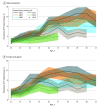Trends in Opioid Misuse Among Individuals Aged 12 to 21 Years in the US
- PMID: 37261827
- PMCID: PMC10236235
- DOI: 10.1001/jamanetworkopen.2023.16276
Trends in Opioid Misuse Among Individuals Aged 12 to 21 Years in the US
Abstract
Importance: Although opioid misuse has been decreasing among US youths and adolescents in recent years, it is unclear what has contributed to this trend and how this trend differs by age group and sex over time.
Objective: To identify trends in opioid misuse among youths and young adults across and between ages, birth cohorts, and sexes.
Design, setting, and participants: Cross-sectional National Survey on Drug Use and Health (NSDUH) public-use files were used to produce nationally representative pseudocohorts. The survey population includes the civilian US population in the 50 states and Washington, DC. Individuals without a fixed address and institutionalized individuals were excluded. Respondents to the NSDUH are a population-based sample selected using a stratified cluster design. For the years (January 1, 2002, to December 31, 2019) and ages (12-21 years) analyzed, the sample sizes ranged from 1607 to 3239 respondents. Data were analyzed from January 1, 2022, to April 12, 2023, for the main outcome by age, sex, and pseudocohort.
Main outcomes and measures: Respondents were asked whether they misused prescription opioids or used heroin in the past year. The analysis hypotheses were formulated and tested after data collection.
Results: In a total of 5 pseudocohorts, data from 114 412 respondents aged 12 to 21 years were analyzed; the unweighted distribution of male sex (complement was female) ranged from 47.7% to 52.6% (mean [SD], 50.6% [1.1%]). Response rates ranged from 45.8% to 71.3%. High school-aged youths and young adults had distinctly lower rates of opioid misuse in later pseudocohorts compared with earlier ones. Rates of misuse among individuals aged 16 years were 2.80% (95% CI, 1.06%-4.54%) higher in 2002 vs 2008; among those aged 18 years, rates were 4.36% (95% CI, 1.85%-6.87%) higher in 2002. Similarly, rates of misuse among individuals aged 16 years were 3.93% (95% CI, 2.15%-5.71%) higher in 2008 vs 2014; among those aged 17 years, rates were 3.41% (95% CI, 1.94%-4.88%) higher in 2008. Similar patterns were observed by sex. In earlier cohorts, younger female participants had higher rates of opioid misuse than their male counterparts and older male participants had higher rates than their female counterparts. Sex differences decreased in later cohorts.
Conclusions and results: The findings of this cross-sectional study of US youths and young adults suggest that high school-aged individuals consistently misused fewer opioids in later pseudocohorts overall and by sex. Sex differences in opioid rates also diminished in later pseudocohorts. A decrease in drug availability and general exposure to the harms of opioid use could be contributing to these findings. Future planned research using this pseudocohort approach will examine polysubstance use and evaluate how substance use differs by other sociodemographic characteristics.
Conflict of interest statement
Figures
References
-
- Centers for Disease Control and Prevention . US overdose deaths in 2021 increased half as much as in 2020. —but are still up 15%. May 11, 2022. Accessed October 3, 2002. https://www.cdc.gov/nchs/pressroom/nchs_press_releases/2022/202205.htm
Publication types
MeSH terms
Substances
Grants and funding
LinkOut - more resources
Full Text Sources
Medical
Miscellaneous



